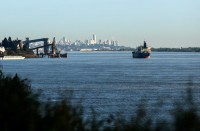![]() The Eiffel Tower isn’t just an attraction for millions of visitors each year but also plays a crucial role in monitoring the French capital’s air quality.
The Eiffel Tower isn’t just an attraction for millions of visitors each year but also plays a crucial role in monitoring the French capital’s air quality.
Regularly, an engineer from air quality watchdog Airparif, takes the lift up to the top of the Eiffel tower, above the many tourists gazing at the city’s stunning views.
A small station monitors levels and concentration of pollutants in the Paris skies, mainly generated by road traffic.
Having a station at this height allows for a better understanding of the dispersion phenomena giving daily data which can be compared to ground stations dotted around the capital.
“The monitoring stations we have on the Eiffel Tower allow us to better understand the air pollution dispersion from up here but also to give us a day’s levels from such a height which will be different to other stations on the ground around Paris,” said Pierre-Emmanuel Burg from Airparif, the air quality watchdog for Paris.
The fight against pollution is a tough one for French authorities. Fifteen years ago, France removed the presence of lead from petrol. Concentrations of lead and benzene in the Paris atmosphere have since dramatically dropped.
Diesel cars account for more than half of the cars on the French roads nowadays and is a high figure compared to other European neighbours. This figure is partly explained by old policies which favoured diesel cars and tax breaks on diesel fuel.
“The removal of lead in petrol is a good example of successful policies. Lead, as well as benzene, were pollutants which posed problems 15 or 20 years ago in France, today levels of lead and benzene are close to nothing or in any case very low, it is still around so we keep monitoring them, however it worked out especially because it posed a health risk in ambient air. By contrast, some policies can sometimes not have a positive outcome, such as the encouraging of diesel use because it produced less CO2 (carbon dioxide) but diesel produces particles. So it’s an example where a policy can have a negative impact on air pollution,” Burg said.
However, France has recently chosen to reduce the tax break for diesel cars. The fuel has faced growing criticism since the World Health Organisation in 2012 classified diesel engine exhaust fumes as carcinogenic.
Paris authorities have on occasion had to resort to emergency traffic restrictions to curb levels of air pollution by lowering speeds in and around the capital.
“The attention is on traffic restrictions but there is a whole variety of measures which authorities can use when a there’s a pollution peak. Traffic restrictions is the most obvious one and when it was used in 2014 and 2015 we studied the impact which showed drops of 6 to 10 percent of pollution levels, in particular in regards to nitrogen dioxide and particles, on some occasions a decrease of up to 20 percent on busy roads such as the peripherique (Paris ring road),” Burg said.
France is preparing to host the United Nations Climate Change Conference (COP21) in December with over 80 world leaders expected to attend.







